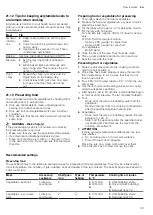
How it works
en
31
¡
The setting values apply to food placed in the cook-
ing compartment while the cooking compartment is
still cold. You can cut your energy use by up to
20%.
It is not usually necessary to preheat the appliance.
If you would like to preheat the oven anyway, you
can reduce the indicated baking times by a few
minutes.
Preheating is required for some types of food. Do
not place accessories into the cooking compart-
ment until it has finished preheating.
¡
Remove any accessories that are not being used
from the cooking compartment. This allows you to
achieve optimal cooking results and save up to 20%
in energy.
¡
Gentle top/bottom heating is an intelligent type of
heating that allows you to gently cook meat, fish
and baked items that do not need to rise. The appli-
ance optimally controls the supply of energy to the
cooking compartment. The food is cooked in
phases using residual heat. This means that the
food remains more succulent and browns less. De-
pending on the preparation and food, you can save
energy. If you preheat the appliance or open the ap-
pliance door before the food has finished cooking,
you may not be able to achieve this result.
The top/bottom heating gentle is used to measure
both the energy consumption in circulating-air mode
and the energy efficiency class.
¡
Only use original accessories.
The original accessory has been tailored to the
cooking compartment and the types of heating.
Ensure that the accessory slides in the right way
round.
Greaseproof paper
Only use greaseproof paper that is suitable for the se-
lected temperature. Always cut the greaseproof paper
to size.
WARNING ‒ Risk of fire!
Opening the appliance door creates a draught.
Greaseproof paper may come into contact with the
heating element and catch fire.
▶
Never place greaseproof paper loosely over ac-
cessories when preheating the appliance and while
cooking.
▶
Always cut greaseproof paper to size and use a
plate or baking tin to hold it down.
21.4 Notes on baking
When baking, use the shelf positions indicated.
Baking on one level
Shelf posi-
tion
Rising pasta/baked goods or tin on the
wire rack
2
Flat pasta/baked items or in the baking
tray
2–3
Note:
For best results, we recommend using dark-col-
oured metal baking tins.
21.5 Cakes and other baked goods
Recommended settings for cakes and baked items
The temperature and baking time depend on the quant-
ity and consistency of the dough. This is why temperat-
ure ranges are given in the tables. Set a short cooking
time first. If required, set a longer cooking time next
time. A lower temperature results in more even brown-
ing.
Baking tips
We have compiled a few tips to help you achieve a
good baking result.
Topic
Tip
You want your cake to
rise evenly.
¡
Only grease the base
of the springform cake
tin.
¡
After baking, use a
knife to carefully
loosen the cake from
the baking tin.
You do not want small
baked goods to stick to
each other when baking.
Leave a minimum clear-
ance of 2 cm around
each item that is to be
baked. This allows
enough space for the
baked goods to expand
and brown on all sides.
Determine whether the
cake is ready.
Push a cocktail stick into
the highest point on the
cake. If the cocktail stick
comes out clean, the
cake is ready.
You want to bake accord-
ing to your own recipe.
Use similar items in the
baking tables as a guide.
Use bakeware made of
silicone, glass, plastic or
ceramic.
¡
The baking tin must be
heat-resistant up to
250 °C.
¡
Cakes in these types
of bakeware brown
less.
















































